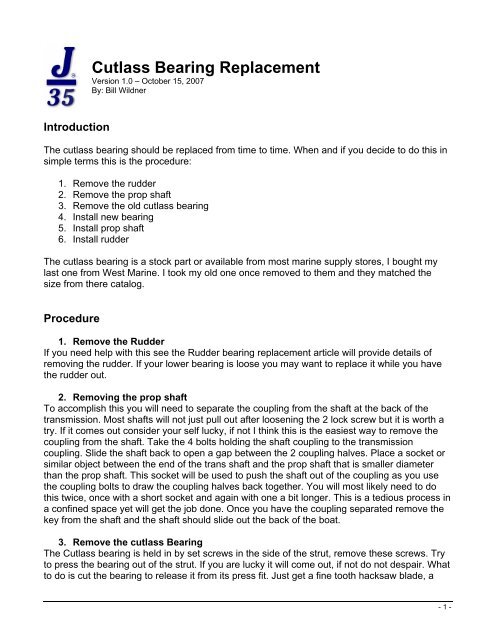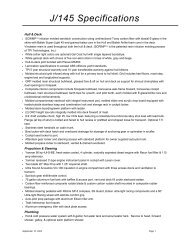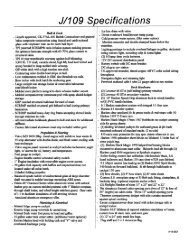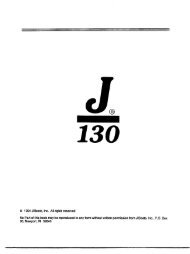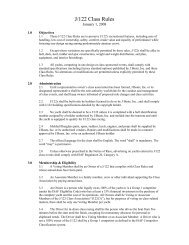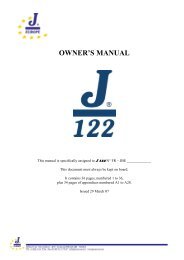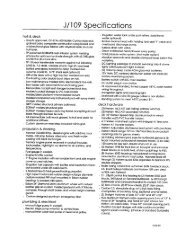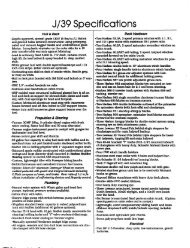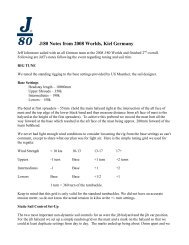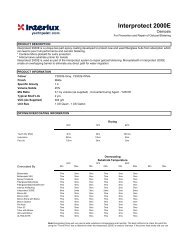Cutlass Bearing Replacement
Cutlass Bearing Replacement
Cutlass Bearing Replacement
Create successful ePaper yourself
Turn your PDF publications into a flip-book with our unique Google optimized e-Paper software.
<strong>Cutlass</strong> <strong>Bearing</strong> <strong>Replacement</strong><br />
Version 1.0 – October 15, 2007<br />
By: Bill Wildner<br />
Introduction<br />
The cutlass bearing should be replaced from time to time. When and if you decide to do this in<br />
simple terms this is the procedure:<br />
1. Remove the rudder<br />
2. Remove the prop shaft<br />
3. Remove the old cutlass bearing<br />
4. Install new bearing<br />
5. Install prop shaft<br />
6. Install rudder<br />
The cutlass bearing is a stock part or available from most marine supply stores, I bought my<br />
last one from West Marine. I took my old one once removed to them and they matched the<br />
size from there catalog.<br />
Procedure<br />
1. Remove the Rudder<br />
If you need help with this see the Rudder bearing replacement article will provide details of<br />
removing the rudder. If your lower bearing is loose you may want to replace it while you have<br />
the rudder out.<br />
2. Removing the prop shaft<br />
To accomplish this you will need to separate the coupling from the shaft at the back of the<br />
transmission. Most shafts will not just pull out after loosening the 2 lock screw but it is worth a<br />
try. If it comes out consider your self lucky, if not I think this is the easiest way to remove the<br />
coupling from the shaft. Take the 4 bolts holding the shaft coupling to the transmission<br />
coupling. Slide the shaft back to open a gap between the 2 coupling halves. Place a socket or<br />
similar object between the end of the trans shaft and the prop shaft that is smaller diameter<br />
than the prop shaft. This socket will be used to push the shaft out of the coupling as you use<br />
the coupling bolts to draw the coupling halves back together. You will most likely need to do<br />
this twice, once with a short socket and again with one a bit longer. This is a tedious process in<br />
a confined space yet will get the job done. Once you have the coupling separated remove the<br />
key from the shaft and the shaft should slide out the back of the boat.<br />
3. Remove the cutlass <strong>Bearing</strong><br />
The <strong>Cutlass</strong> bearing is held in by set screws in the side of the strut, remove these screws. Try<br />
to press the bearing out of the strut. If you are lucky it will come out, if not do not despair. What<br />
to do is cut the bearing to release it from its press fit. Just get a fine tooth hacksaw blade, a<br />
- 1 -
new blade will help with this job. Assemble the hacksaw with the blade running through the<br />
inside of the bearing. Carefully cut the bearing with the saw. The object is to make one fine<br />
even cut along the length of the bearing. This will release the bearing and it will nearly fall out.<br />
4. Install new bearing<br />
Before installing the new bearing de-burr the inside diameter of the strut so as not to cause<br />
problems when the new bearing is pressed in. The new bearing can be pressed in with a<br />
variety of methods. One way is to use a treaded rod long enough to go through the strut and<br />
the bearing with nuts and washers on both ends. Tighten the nuts to draw the bearing into the<br />
strut. Also a large C-clamp can be used but is a bit difficult to get the proper alignment. It can<br />
also be tapped in with a hammer of it is not a real tight fit. Just make sure not to deform the<br />
end of the bearing with a hammer. The most important part and what can cause this process to<br />
go bad is one of the following: Burrs or dents on the strut, or misalignment of the bearing,<br />
either one will cause the bearing to bind and deform if forced causing the prop shaft to be tight<br />
once installed, Once the bearing is in place you may need to trim or file the ends to clean them<br />
up. Tighten the lock screws very gently as this can also deform the bearing, I recommend<br />
some Loctite or epoxy on the set screws so they do not come loose.<br />
5. Reinstall the propeller shaft<br />
Before reinstalling the prop shaft consider replacing the shaft packing or installing one of the<br />
drip-less seals. Inspect the shaft for excessive wear at the packing area. Also get the coupling<br />
and clean up the inside of it and the end of the shaft and check that they fit snug also inspect<br />
the key and replace if it has much wear. Once all of these items are confirmed to be ready<br />
reinstall the prop shaft. You may need to tap it into the coupling, have a friend do this from<br />
outside the boat as you watch for when the shaft is in the coupling as far as needed to line up<br />
the set screw hole with the accompanying depression in the shaft. Bolt it all up and safety wire<br />
the lock screws. Check that the shaft turns free. The new bearing may impart light friction on<br />
the shaft, this will free up after a few hours of use.<br />
6. Reinstall the rudder<br />
Refer to the Lower rudder bearing replacement article for detailed instructions in replacing the<br />
rudder.<br />
- 2 -


